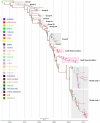Molecular Epidemiology and Spatio-Temporal Dynamics of the H3N8 Equine Influenza Virus in South America
- PMID: 27754468
- PMCID: PMC5198161
- DOI: 10.3390/pathogens5040061
Molecular Epidemiology and Spatio-Temporal Dynamics of the H3N8 Equine Influenza Virus in South America
Abstract
Equine influenza virus (EIV) is considered the most important respiratory pathogen of horses as outbreaks of the disease lead to substantial economic losses. The H3N8 EIV has caused respiratory disease in horses across the world, including South American countries. Nucleotide and deduced amino acid sequences for the complete haemagglutinin gene of the H3N8 EIV detected in South America since 1963 were analyzed. Phylogenetic and Bayesian coalescent analyses were carried out to study the origin, the time of the most recent common ancestors (tMRCA), the demographic and the phylogeographic patterns of the H3N8 EIV. The phylogenetic analysis demonstrated that the H3N8 EIV detected in South America grouped in 5 well-supported monophyletic clades, each associated with strains of different origins. The tMRCA estimated for each group suggested that the virus was circulating in North America at least one year before its effective circulation in the South American population. Phylogenetic and coalescent analyses revealed a polyphyletic behavior of the viruses causing the outbreaks in South America between 1963 and 2012, possibly due to the introduction of at least 4 different EIVs through the international movement of horses. In addition, phylodynamic analysis suggested South America as the starting point of the spread of the H3N8 EIV in 1963 and showed migration links from the United States to South America in the subsequent EIV irruptions. Further, an increase in the relative genetic diversity was observed between 2006 and 2007 and a subsequent decline since 2009, probably due to the co-circulation of different lineages and as a result of the incorporation of the Florida clade 2 strain in vaccines, respectively. The observed data highlight the importance of epidemiological surveillance and the implementation of appropriate quarantine procedures to prevent outbreaks of the disease.
Keywords: South America; equine influenza; haemagglutinin; phylodynamics; phylogeography.
Conflict of interest statement
The authors declared no conflict of interest.
Figures




Similar articles
-
An Overview of Equine Influenza in South America.Viruses. 2021 May 12;13(5):888. doi: 10.3390/v13050888. Viruses. 2021. PMID: 34065839 Free PMC article. Review.
-
Equine Influenza Virus in Asia: Phylogeographic Pattern and Molecular Features Reveal Circulation of an Autochthonous Lineage.J Virol. 2019 Jun 14;93(13):e00116-19. doi: 10.1128/JVI.00116-19. Print 2019 Jul 1. J Virol. 2019. PMID: 31019053 Free PMC article.
-
Multifocal outbreak of equine influenza in vaccinated horses in Argentina in 2018: Epidemiological aspects and molecular characterisation of the involved virus strains.Equine Vet J. 2020 May;52(3):420-427. doi: 10.1111/evj.13176. Epub 2019 Oct 4. Equine Vet J. 2020. PMID: 31494962
-
Investigation of cross-regional spread and evolution of equine influenza H3N8 at US and global scales using Bayesian phylogeography based on balanced subsampling.Transbound Emerg Dis. 2022 Sep;69(5):e1734-e1748. doi: 10.1111/tbed.14509. Epub 2022 Mar 16. Transbound Emerg Dis. 2022. PMID: 35263501
-
Epidemiology of equine influenza in the Maghreb area.Comp Immunol Microbiol Infect Dis. 2022 Oct;89:101868. doi: 10.1016/j.cimid.2022.101868. Epub 2022 Sep 6. Comp Immunol Microbiol Infect Dis. 2022. PMID: 36087448 Review.
Cited by
-
First Molecular Detection and Epidemiological Analysis of Equine Influenza Virus in Two Regions of Colombia, 2020-2023.Viruses. 2024 May 24;16(6):839. doi: 10.3390/v16060839. Viruses. 2024. PMID: 38932133 Free PMC article.
-
Immunogenicity of Calvenza-03 EIV/EHV® Vaccine in Horses: Comparative In Vivo Study.Vaccines (Basel). 2021 Feb 17;9(2):166. doi: 10.3390/vaccines9020166. Vaccines (Basel). 2021. PMID: 33671378 Free PMC article.
-
An Overview of Equine Influenza in South America.Viruses. 2021 May 12;13(5):888. doi: 10.3390/v13050888. Viruses. 2021. PMID: 34065839 Free PMC article. Review.
-
Equine Influenza Virus: An Old Known Enemy in the Americas.Vaccines (Basel). 2022 Oct 14;10(10):1718. doi: 10.3390/vaccines10101718. Vaccines (Basel). 2022. PMID: 36298583 Free PMC article. Review.
-
Seroprevalence of Equine Influenza Virus Antibodies in Horses from Four Localities in Colombia.Viruses. 2025 Jul 16;17(7):999. doi: 10.3390/v17070999. Viruses. 2025. PMID: 40733615 Free PMC article.
References
-
- Woodward A.L., Rash A.S., Blinman D., Bowman S., Chambers T.M., Daly J.M., Damiani A., Joseph S., Lewis N., McCauley J.W., et al. Development of a surveillance scheme for equine influenza in the UK and characterisation of viruses isolated in Europe, Dubai and the USA from 2010–2012. Vet. Microbiol. 2014;169:113–127. doi: 10.1016/j.vetmic.2013.11.039. - DOI - PubMed
-
- Sovinova O., Tumova B., Pouska F., Nemec J. Isolation of a virus causing respiratory disease in horses. Acta Virol. 1958;2:52–61. - PubMed
LinkOut - more resources
Full Text Sources
Other Literature Sources

